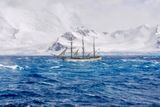The sinking of the Endurance, a ship famously led by Sir Ernest Shackleton during his 1914 expedition, may have been influenced by structural flaws that compromised its ability to navigate harsh Antarctic conditions. A study published in Polar Record by polar explorer and scientist Jukka Tuhkuri suggests that the vessel was not adequately designed for the pressures of the icy environment, raising questions about the decisions made by Shackleton prior to the voyage.
The Endurance embarked on its ambitious journey in January 1914, aiming for the first-ever crossing of the Antarctic continent. However, the ship soon became trapped in pack ice after losing its rudder, eventually sinking in the Weddell Sea in 1915. The wreck, located in 2022 at nearly 10,000 feet below the surface, has been remarkably preserved and is now a protected historic site.
Tuhkuri, a professor of solid mechanics at Aalto University in Finland, utilized expedition diaries, Shackleton’s personal correspondence, and a naval architectural analysis to investigate the ship’s structural integrity. His research uncovered significant insights into the factors leading to the Endurance’s demise.
Uncovering Structural Oversights
The findings indicated that the Endurance was inadequately equipped to withstand the compressive forces of pack ice. Tuhkuri noted, “Even simple structural analysis shows that the ship was not designed for the compressive pack ice conditions that eventually sank it.” He compared the Endurance with other polar ships of the era and identified several structural deficiencies, including weaker deck beams, a longer machine compartment that compromised hull integrity, and a lack of diagonal beams for additional support.
Tuhkuri clarified that the ship’s final failure stemmed from a damaged keel, but it was its overall design that made it vulnerable to the extreme conditions of the Antarctic. He emphasized that this challenges the prevailing narrative of the Endurance as the strongest polar ship of its time.
Shackleton’s Awareness of Limitations
The study raises intriguing questions about Shackleton’s choices. Tuhkuri pointed out that the dangers posed by moving ice and compressive loads were well understood before the Endurance set sail. He remarked, “We really have to wonder why Shackleton chose a vessel that was not strengthened for compressive ice.”
In his correspondence, Shackleton expressed frustration regarding the ship’s limitations, indicating he preferred vessels from earlier expeditions. Tuhkuri cited a letter where Shackleton recommended diagonal beams for another polar ship he visited, emphasizing that such design choices could have made a significant difference.
While Shackleton’s awareness of the Endurance’s flaws is evident, the exact reasons for his decisions remain speculative. Tuhkuri acknowledged, “We can speculate about financial pressures or time constraints, but the truth is, we may never know why Shackleton made the choices that he made.”
Despite the ship’s tragic fate, the Endurance expedition is celebrated for the crew’s remarkable survival under Shackleton’s leadership. Their story endures as a defining moment of the Heroic Age of Antarctic Exploration, illustrating human resilience in the face of extreme adversity.
The investigation into the Endurance highlights the importance of understanding historical contexts in maritime design and exploration, offering lessons that resonate beyond the icy waters of the Antarctic.
